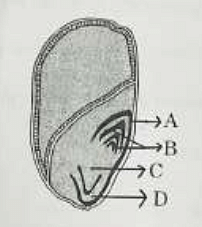Question:
Which of the following annuals require the isolation distance of 50-100 meters for seed production?
(A) Antirrhinum
(B) Marigold
(C) Larkspur
(D) Nasturtium
Choose the correct answer from the options given below:
Which of the following annuals require the isolation distance of 50-100 meters for seed production?
(A) Antirrhinum
(B) Marigold
(C) Larkspur
(D) Nasturtium
Choose the correct answer from the options given below:
(A) Antirrhinum
(B) Marigold
(C) Larkspur
(D) Nasturtium
Choose the correct answer from the options given below:
Show Hint
Isolation distance for seed production depends on how easily a plant cross-pollinates.
Highly cross-pollinated (by wind or insects): Need larger distances.
Mostly self-pollinated: Need smaller distances. Antirrhinum (snapdragon) and Larkspur are known to be significantly cross-pollinated by insects, thus requiring good isolation like 50-100m.
Highly cross-pollinated (by wind or insects): Need larger distances.
Mostly self-pollinated: Need smaller distances. Antirrhinum (snapdragon) and Larkspur are known to be significantly cross-pollinated by insects, thus requiring good isolation like 50-100m.
Updated On: Jun 3, 2025
- (A), (B) and (C) only.
- (A) and (C) only.
- (B), (C) and (D) only.
- (A) and (D) only.
Hide Solution
Verified By Collegedunia
The Correct Option is B
Solution and Explanation
Isolation distance in seed production is the minimum distance required between different varieties of the same crop, or related species, to prevent cross-pollination and maintain genetic purity. The distance varies depending on the crop's breeding system (self-pollinated vs. cross-pollinated) and the pollinating agent (wind, insects). A distance of 50-100 meters suggests a moderate level of outcrossing, often insect-pollinated.
Let's consider the pollination mechanism of the given annuals:
(A) Antirrhinum (Snapdragon): Primarily cross-pollinated by bees. It requires a significant isolation distance to prevent contamination. 50-100 meters (or even more for foundation seed) is plausible.
(B) Marigold (Tagetes spp.): Often considered self-pollinating or with a low degree of outcrossing, though some insect activity can occur. Typically requires smaller isolation distances (e.g., 10-50 meters, or less for highly self-pollinating types).
(C) Larkspur (Delphinium spp. or Consolida spp.): Primarily cross-pollinated by bees and other insects. It would require a substantial isolation distance. 50-100 meters is plausible.
(D) Nasturtium (Tropaeolum majus): Pollinated by insects. It is cross-pollinated to a good extent but might not always require as large an isolation as strongly outcrossing species; however, some sources do recommend distances in the 50-100m range or more for purity. Comparing these, Antirrhinum and Larkspur are more consistently recognized as requiring substantial isolation due to insect-mediated cross-pollination. Marigold generally requires less. Nasturtium can be variable but often needs good isolation too. If the correct answer is (2) (A) and (C) only, it implies that Antirrhinum and Larkspur are considered to fit the 50-100m requirement, while Marigold requires less, and Nasturtium is either considered to require less or significantly more, or is excluded for other reasons in this specific context. The 50-100m range is often recommended for foundation seed of moderately cross-pollinated species. Antirrhinum and Larkspur fit this category well. (A) and (C) only.
(A) Antirrhinum (Snapdragon): Primarily cross-pollinated by bees. It requires a significant isolation distance to prevent contamination. 50-100 meters (or even more for foundation seed) is plausible.
(B) Marigold (Tagetes spp.): Often considered self-pollinating or with a low degree of outcrossing, though some insect activity can occur. Typically requires smaller isolation distances (e.g., 10-50 meters, or less for highly self-pollinating types).
(C) Larkspur (Delphinium spp. or Consolida spp.): Primarily cross-pollinated by bees and other insects. It would require a substantial isolation distance. 50-100 meters is plausible.
(D) Nasturtium (Tropaeolum majus): Pollinated by insects. It is cross-pollinated to a good extent but might not always require as large an isolation as strongly outcrossing species; however, some sources do recommend distances in the 50-100m range or more for purity. Comparing these, Antirrhinum and Larkspur are more consistently recognized as requiring substantial isolation due to insect-mediated cross-pollination. Marigold generally requires less. Nasturtium can be variable but often needs good isolation too. If the correct answer is (2) (A) and (C) only, it implies that Antirrhinum and Larkspur are considered to fit the 50-100m requirement, while Marigold requires less, and Nasturtium is either considered to require less or significantly more, or is excluded for other reasons in this specific context. The 50-100m range is often recommended for foundation seed of moderately cross-pollinated species. Antirrhinum and Larkspur fit this category well. (A) and (C) only.
Was this answer helpful?
0
0
Top Questions on The Seed
- In the seeds of cereals, the outer covering of endosperm separates the embryo by a protein-rich layer called:
- What is the ideal seed rate for okra for rainy season crop?
- Which of the following is true for essentiality of germination? (A) Viability of seed
(B) Proper environment
(C) Seed free from dormancy
(D) Thin seed coat - Given below are two statements:
Statement (I): The non deep type is the most common primary dormancy
Statement (II): In this type of dormancy species require light or darkness to germinate or chilling stratification
In light of the above statements, choose the most appropriate answer from the options given below Identify the part of the seed from the given figure which is destined to form root when the seed germinates.

View More Questions
Questions Asked in ICAR AIEEA exam
- Which fiber is known for its excellent moisture-wicking properties, making it ideal for active wear?
- Which is NOT a feature of a cooperative society?
- ICAR AIEEA (PG) - 2025
- Marketing
- Which is the recommended protein level for carp grow-out feed?
- ICAR AIEEA (PG) - 2025
- Fish Nutrition
- The 'Law of the Minimum' was proposed by:
- ICAR AIEEA (PG) - 2025
- Agronomic Principles
- In the context of agribusiness, SWOT analysis is used to assess:
- ICAR AIEEA (PG) - 2025
- Principles and Functions of Management
View More Questions